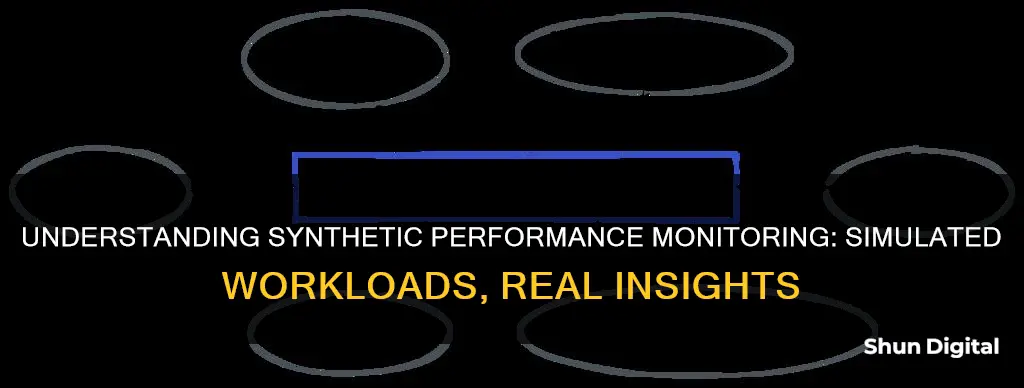
Synthetic performance monitoring is a technique used to monitor the performance of a website or application by simulating user interactions in a laboratory environment. It involves using scripted recordings or behavioural scripts to emulate user behaviour and interactions with a website or application. This data is then used to evaluate the performance of the website or application, including metrics such as uptime, availability, and response times. Synthetic performance monitoring is often used to identify and fix performance issues before they affect real users and can be used to test new features and modules during different times of the day and in different scenarios.
| Characteristics | Values |
|---|---|
| Type of monitoring | Active, proactive, synthetic |
| Purpose | To test a website or web service |
| Method | Simulating visitor requests |
| Data generated | Simulated transactions |
| Data analysis | Evaluate how the system behaves |
| Use | Determine whether a website achieves desired page load, response times and uptimes |
| Use case | Assess how a system is likely to respond to user requests |
| Use case | Assess a system's response to unusual or infrequent requests |
| Use case | Regression testing |
| Use case | Production site monitoring |
| Use case | Test new product features before launching |
| Use case | Monitor third-party APIs and critical business processes |
What You'll Learn

Simulating user interactions
Synthetic monitoring is a technique used in software, web, and electronic product design to monitor the performance of a site, application, or software by simulating user behaviour. It involves creating behavioural scripts or paths that mimic the actions of a typical user, and then continuously monitoring these paths at specified intervals to measure performance in terms of functionality, availability, and response times.
For example, a script for a website might include opening the website, clicking on specific links or buttons, filling out forms, or interacting with certain features. For an application, a script might involve launching the app, signing in, navigating through different menus or functionalities, and performing specific tasks.
The complexity of these simulated user interactions can vary. Simple simulations might only involve a few basic actions, while more advanced simulations can include a wide range of user behaviours, including complex interactions with the product.
The goal of simulating user interactions is to replicate how a real user would engage with the product. This allows for a more accurate assessment of the product's performance and helps identify any issues or bottlenecks that may impact the user experience.
By simulating user interactions, synthetic monitoring provides a proactive approach to testing. It enables professionals to identify and address problems before they affect actual users, ensuring a smoother and more reliable experience for customers.
Additionally, synthetic monitoring offers the advantage of testing without the need for real user traffic. This means that companies can test applications 24/7 and even test new applications before they are released to the public.
Overall, simulating user interactions is a key component of synthetic monitoring, helping to ensure the performance, functionality, and reliability of websites, applications, and software products.
Monitoring Performance: Effective Strategies and Techniques
You may want to see also

Testing a website or web service
Synthetic performance monitoring, also known as active or proactive monitoring, is a technique used in software, web, and electronic product design. It involves creating behavioural scripts that simulate a user's actions or paths on a website, application, or software. These scripts are then continuously monitored at specified intervals to measure performance, including functionality, availability, and response time.
When testing a website or web service, synthetic performance monitoring can be a valuable tool. Here are some ways to utilise it:
- Monitor Commonly Trafficked Paths: Synthetic monitoring is ideal for simulating typical user behaviour and navigation through a website. Focus on monitoring the paths that users commonly take to identify potential issues or bottlenecks.
- Measure Critical Metrics: Synthetic tests can measure key metrics such as uptime, availability, and response time of critical pages and transactions. This helps ensure that your website or service performs optimally from all geographies.
- Identify Performance Issues: By simulating real user traffic, synthetic testing can proactively identify performance issues with user journeys. This includes monitoring the availability of services, the response time of applications, and the functionality of customer transactions.
- Continuous Monitoring: Synthetic tests can be deployed manually or through a monitoring platform that automatically runs the tests at predefined intervals. This enables continuous monitoring, allowing you to catch issues before they impact your end users.
- Baseline Performance: Synthetic testing helps establish a baseline for application performance at different times of the day and in different locations. This data can be used to optimise your website or service to meet user expectations.
- Proactive Troubleshooting: When a synthetic test fails, a monitoring platform can provide access to related data such as backend requests, error logs, and network timings. This information enables quick troubleshooting and problem-solving before issues become critical.
- Validate New Features: Synthetic tests can be run in production or test environments to ensure that new features or changes are functioning correctly before they are deployed to end users. This helps minimise the risk of introducing performance regressions.
- Launch in New Markets: If expanding to a new geographic market, synthetic testing can validate the expected performance of your website or service in that location, even before real user traffic is present.
- API and Browser Tests: Utilise both API and browser synthetic tests. API tests monitor key endpoints at every network layer, while browser tests check if users can complete important transactions like account sign-up or checkout.
- Combine with Real User Monitoring (RUM): While synthetic testing simulates user behaviour, RUM records real user transactions. Combining these approaches can provide a comprehensive view of user experience and help identify issues that synthetic testing alone might miss.
LCD vs LED Monitors: Which Display Technology is Better?
You may want to see also

Monitoring third-party APIs
Synthetic monitoring is a technique used in software, web, and electronic product design to simulate or record user behaviour and interactions with a website, application, or software. This is done by creating behavioural scripts or paths that mimic user actions, which are then continuously monitored at set intervals to track metrics such as functionality, availability, and response times. This proactive approach allows for the early identification of potential issues, ensuring a smooth user experience.
Now, monitoring third-party APIs is an essential aspect of synthetic performance monitoring. Third-party APIs are integral to modern mobile applications, providing various functionalities and services. However, they also introduce additional complexity and potential failure points. By monitoring third-party APIs, developers can ensure their proper functioning and maintain the performance of their applications.
New Relic offers comprehensive solutions for monitoring third-party APIs. With New Relic for Mobile Apps, developers can monitor the performance of connections between their apps and third-party APIs. This includes tracking metrics such as response time, throughput, data transfer size, error rates, and active users. New Relic's platform also includes plugins to monitor specific third-party services, such as Azure SQL Databases and Microsoft SQL Server.
Furthermore, New Relic's Service Maps feature helps identify all connections between applications, external services, web services, databases, and APIs. This capability assists in spotting unknown dependencies and planning cloud migration projects effectively. Additionally, New Relic's open instrumentation approach, with APIs like New Relic Metrics and New Relic Traces, enables the collection of metric and trace data from various sources, including third-party vendors. This data aggregation enhances observability and facilitates troubleshooting across the entire application stack.
By leveraging New Relic's tools for monitoring third-party APIs, developers can proactively identify and address potential issues, ensuring optimal performance and user satisfaction.
Best Monitor Mounts: Where to Buy Them
You may want to see also

Fixing performance issues
Synthetic monitoring is a proactive approach to testing a website or web service by simulating user requests to test for availability, performance, and function. It is a monitoring technique that is done by using a simulation or scripted recordings of transactions.
Synthetic monitoring enables IT teams to detect issues before real users are impacted. It provides a comprehensive view of network performance, regardless of whether there are real users currently active on the network.
Proactive issue detection:
Synthetic monitoring enables IT teams to detect issues before they impact real users. By simulating user interactions, IT teams can identify and resolve issues before they escalate into major problems. This helps to ensure that network resources are available and responsive, leading to increased user satisfaction.
Comprehensive network monitoring:
Synthetic monitoring provides a comprehensive view of network performance, even when there are no real users active on the network. It can also simulate various user scenarios, such as high traffic loads, to test network capacity and scalability. This information can be used to optimize network performance and improve the user experience.
Performance optimization:
Synthetic monitoring helps IT teams optimize network performance by identifying bottlenecks and areas for improvement. By monitoring response times and availability of network resources, IT teams can take steps to improve performance and ensure that applications are meeting user expectations.
Reduce mean time to resolution (MTTR):
When a synthetic test fails, an effective synthetic monitoring platform will provide access to related data such as backend requests, error logs, and network timings. These correlations give you the context needed for quick troubleshooting and reduce the time required to resolve issues.
Continuous improvement:
Synthetic monitoring can be used to establish a baseline for application performance and continuously monitor for deviations or issues. By regularly testing and comparing current and historical performance data, IT teams can identify trends, patterns, and areas for improvement. This allows for proactive performance optimization and ensures that applications are meeting user expectations.
Pair with real user monitoring:
While synthetic monitoring is a powerful tool, it may not capture all user-facing issues. Pairing it with real user monitoring (RUM) can help bridge the gap between real and simulated activity and ensure full coverage. RUM captures the performance of actual users and provides valuable user experience data, allowing for a more comprehensive understanding of performance issues.
Removing Mini Source Monitor in Adobe Premiere: A Step-by-Step Guide
You may want to see also

Running constant tests
Synthetic monitoring solutions enable developers to assess a system's response to user requests and validate its performance and availability. This proactive approach allows for the early detection of problems, such as slow response times or downtime, by simulating typical user behaviour. These tests can be run 24/7, even during peak hours, without disrupting real user traffic.
The data generated from synthetic monitoring provides information about critical business transactions, application availability, website speed, and more. For example, developers can answer questions such as whether the site is functioning, how fast it is, if third-party APIs are operational, and if there are any hardware faults.
Synthetic monitoring tools offer a predictive view of user experience and help developers understand the impact of changes or updates. They can be used to test new features and modules in different scenarios, ensuring a smooth user experience. Additionally, synthetic monitoring can be employed to test a website's or application's scaling capabilities by simulating high traffic conditions.
By running constant tests, developers can proactively identify and address performance issues, ensuring a seamless user experience. Synthetic monitoring is a valuable tool for maintaining the functionality and availability of websites and applications, providing insights that can be acted upon to enhance performance.
Is Your Monitor Mirrored? Check with These Steps
You may want to see also
Frequently asked questions
Synthetic performance monitoring is a technique used to monitor the performance of a website or application by simulating user interactions in a controlled environment. It involves running constant tests to gather information about critical business transactions, application availability, website speed, etc.
Synthetic performance monitoring works by deploying scripts that simulate the paths or interactions of end users with a website or application. These scripts are run at specific intervals to monitor performance metrics such as functionality, availability, and response times.
Synthetic performance monitoring offers several benefits:
- Identifying and fixing performance issues before they affect end users
- Benchmarking website performance against competitors
- Testing scaling capabilities and new product features
- Monitoring third-party APIs and critical business processes
- Ensuring compliance with Service Level Agreements (SLAs)
Some popular synthetic monitoring tools include:
- New Relic's Synthetics
- F5's Distributed Cloud Synthetic Monitoring
- Data Dog's Automated Synthetic Monitoring
- Powerhouse Nudge Synthetic Monitoring by Atakama Technologies







